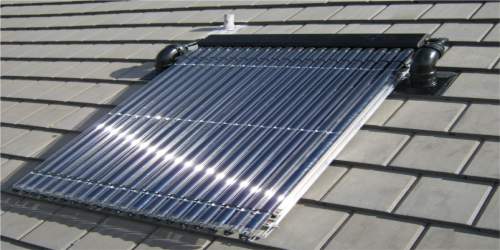Read Time : 4 Minutes
How do Solar Thermal Panels work
The basic principals behind modern solar thermal systems
The basic principle of solar thermal heating is to utilize the sun’s energy and convert it into heat which is then transferred into your home or business heating system in the form of hot water and space heating. The main source of heat generation is through roof mounted solar panels which are used in conjunction with a boiler, collector or immersion heater. The solar collector will use the sun's rays to heat a transfer fluid which is usually a mixture of water and glycol (antifreeze) which prevents the water from freezing. The heated water from the collectors is pumped to a heat exchanger which would be inside the water tank in your home. The heat from the exchanger will then heat the water inside the tank. After the liquid releases its heat, the water will flow back to the collectors for reheating. A controller will ensure that the fluid will circulate to the collector when there is sufficient heat available. 

COMPARE PRICES FROM LOCAL INSTALLERS
Compare prices from local companies fast & free
Enter your postcode to compare quotes from leading professionals. We promise to keep your information Safe & Secure. Privacy Policy
Solar thermal system components
The collector is the main component of a solar thermal system and would in most cases be installed on the roof of the property. The collector contains specially coated reinforced glass pipes to capture the radiation emitted from the sun, which can then be transferred into heat. The pipes themselves will be embedded in an insulated container to prevent heat energy being lost. The heat transfer fluid in the pipes will include eco-friendly antifreeze and will circulate through the collector and hot water tank. In terms of the hot water tanks, there are two kinds that would be in operation. The first is used for heating drinking water and would normally consist of a steel tank filled with drinking water and a heat exchanger. The second would be a combination tank which would supply both drinking water and hot water to the heating system.
The tank that incorporates the duel system would in fact have two smaller tanks inside to keep the water separated for the different tasks. There would also be two heat exchangers which would connect to the collectors and the boiler. The solar water heating system would be connected to the lower exchanger and the boiler to the above exchanger. The whole system can be operated from a solar thermal controller which can be automated. When the temperature at the collectors rises to a specific temperature above the temperature in the storage tank, the controller will automatically switch on the pump and the transfer fluid heated in the collector will be sent to the hot water tank. A typical collector storage tank can hold up to 30 gallons per person.
Solar thermal and the UK climate
It is a common misconception that the climate of the United Kingdom makes it unsuitable for the use of solar technology. Solar collectors do not require bright sunlight in order to function; they simply require light and while bright sunlight is obviously ideal, they can still heat water even on cloudy days as solar radiation is still present. It will be necessary to use a boiler or immersion heater as a backup system to provide an extra boost to your property's hot water generation during winter. A solar water heat system is designed in most cases to meet up to 100% of water heating needs during summer allowing the regular heating system to remain unused.
Over the course of a year it will meet in the region of 50% to 60% of needs. Ultimately the determining factors for usage will come from the type of climate and the size of the solar thermal system that you have installed. The overall rate of water usage will also be a determining factor. In most cases hot water usage will remain consistent which will impact positively on cost effectiveness.
Applications for solar thermal systems
The main ideal application for this technology would be in a residential setting where there is a need to reduce a large energy bill although the technology can also be applied to a commercial setting. The most cost benefit will be will be to facilities with high energy demands and which have heating systems that are expensive to operate. It is a relatively simple process to integrate a solar thermal system into an existing hot water system. Adding a Solar thermal system will greatly improve efficiency over a standard system and can last for over twenty years.
A standard solar water heating system will contain the following components:
- solar thermal panels (sometimes also called collectors), mounted on your roof or on the ground using brackets and frames (flat plate or evacuated tubes)
- heat transfer fluid - this can be water, ethylene glycol (commonly known as anti-freeze), or a mixture of the two
- a coil heat exchanger within a water cylinder - this ‘twin coil’ cylinder will replace your existing cylinder and include a backup coil from your existing boiler to provide extra water heating when required
- a pump which circulates the heat transfer fluid between panels and cylinder (the pump is usually powered by mains electricity, but can also be powered by a small photovoltaic cell)
- insulated pipes between the panels and the water cylinder - called flow and return piping
- a system control panel which controls the heat transfer fluid pump and provides information on the system’s performance, as well as any faults should one develop
- a heat flow generation meter, which measures the output of the system
Look here for solar water heating installation and solar thermal installer.
How do solar thermal panels work with your heating system
Solar thermal panels, when integrated with a modern home heating system, offer a sustainable and efficient solution to meet the energy demands of households. Unlike traditional photovoltaic solar panels that convert sunlight into electricity, solar thermal panels harness the sun's energy to directly heat water, which can then be used for space heating, domestic hot water, and even pool heating.
The synergy between solar thermal panels and a modern home heating system brings numerous benefits to homeowners and the environment alike. Firstly, solar thermal panels can significantly reduce the reliance on conventional heating sources like natural gas or electricity, thereby lowering greenhouse gas emissions and mitigating the impact of global warming. By tapping into an abundant and renewable energy source, homeowners can substantially shrink their carbon footprint.
Moreover, the integration of solar thermal panels enhances energy independence and shields homeowners from fluctuating energy prices. As solar energy is freely available, it insulates households from the volatility of fossil fuel markets, offering a more predictable and stable energy source in the long run.
In addition to the environmental and economic advantages, this combination ensures a reliable and consistent supply of hot water for heating and other purposes. The modern home heating system can be equipped with a backup heating source, like a heat pump or a conventional boiler, to provide heating during cloudy days or when solar energy alone cannot meet the demand. This backup system ensures uninterrupted heating, maintaining comfort throughout the year.
The versatility of solar thermal panels also allows for easy integration into various heating setups. Whether as a supplement to an existing heating system or as the primary heat source, solar thermal panels can be tailored to fit the specific needs of different households. Additionally, advancements in technology have made these panels more efficient and cost-effective, making them an attractive investment for homeowners looking to reduce their energy bills while contributing to a cleaner planet.
In conclusion
The combination of solar thermal panels with a modern home heating system brings a myriad of benefits, including reduced environmental impact, enhanced energy independence, and consistent hot water supply. As the world increasingly seeks sustainable solutions to combat climate change, embracing this eco-friendly heating option paves the way for a greener future for both individuals and the planet.
Find a local installer
Welcome to the biggest directory of UK renewable energy companies





 How do Solar Thermal Panels work
How do Solar Thermal Panels work






